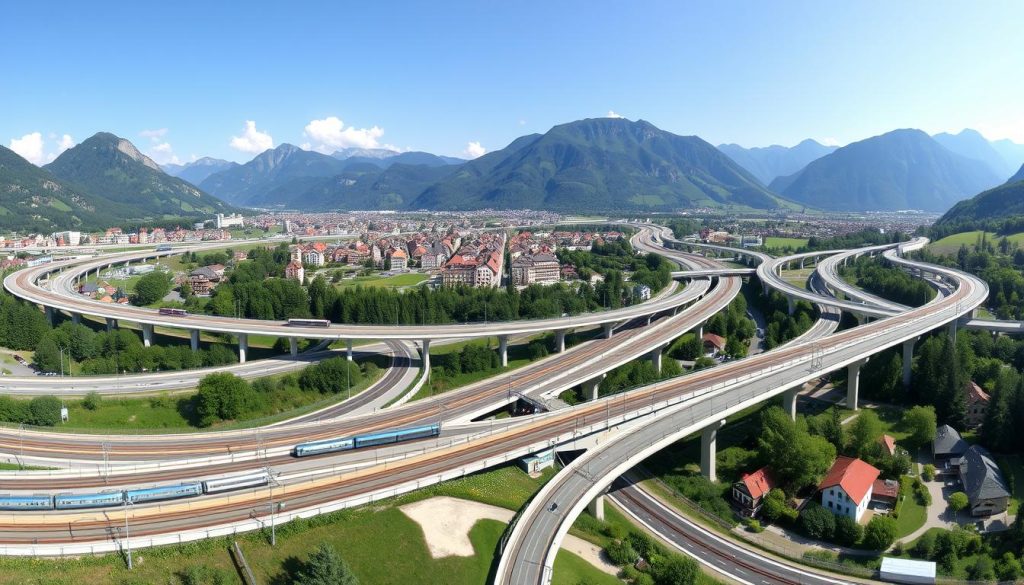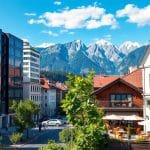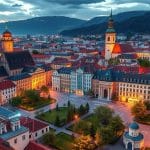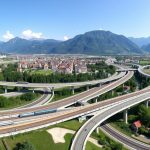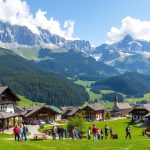The infrastructure in Austria is key for economic growth and social progress. This article looks at the latest trends in Austrian infrastructure. It focuses on transport systems and utilities, showing how they help connect the country and drive progress.
We also explore new innovations and the challenges they bring. Our goal is to give a full view of Austria’s infrastructure. This will show its importance in shaping the country’s future.
Introduction to Austrian Infrastructure
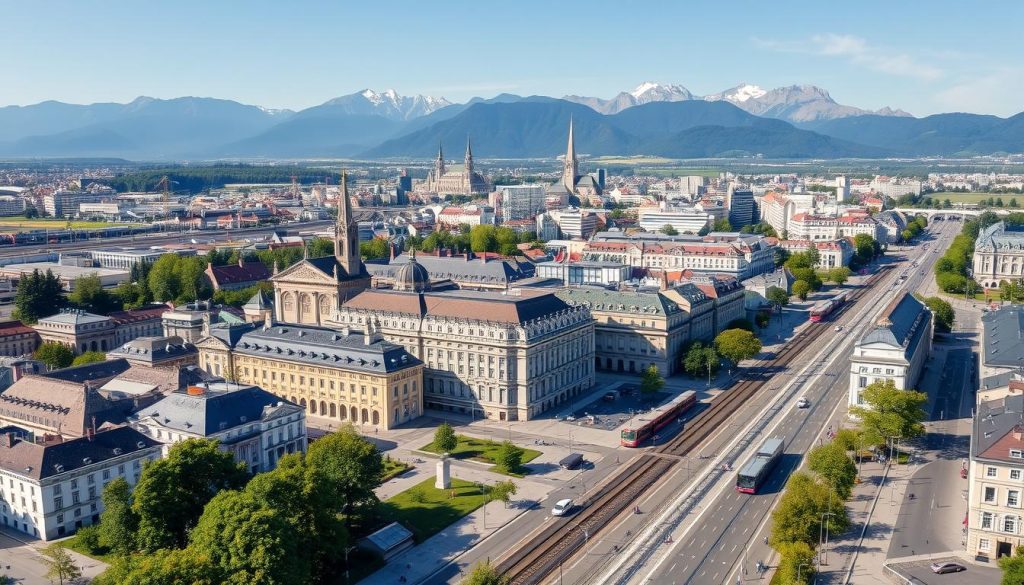
A comprehensive Austrian infrastructure introduction shows a well-developed network. It is crucial for the nation’s operations. The infrastructure supports economic growth, improves quality of life, and promotes sustainability.
People and businesses depend on transport, utilities, and telecommunication systems. These are key for local and international interactions.
Austria’s location in Europe is key. It connects Eastern and Western Europe, boosting trade and mobility. Major transport networks, like railways, roads, and air routes, make it easy to move people and goods.
The utility infrastructure in Austria delivers essential services like water, energy, and waste management. It’s vital for public health and environmental standards. Telecommunication networks, including broadband and mobile, ensure smooth communication.
These infrastructure elements show Austria’s dedication to economic strength and business appeal. It’s committed to technology and sustainability. The future of Austrian infrastructure promises to improve connectivity and benefit its people and economy.
Historical Overview of Infrastructure Development
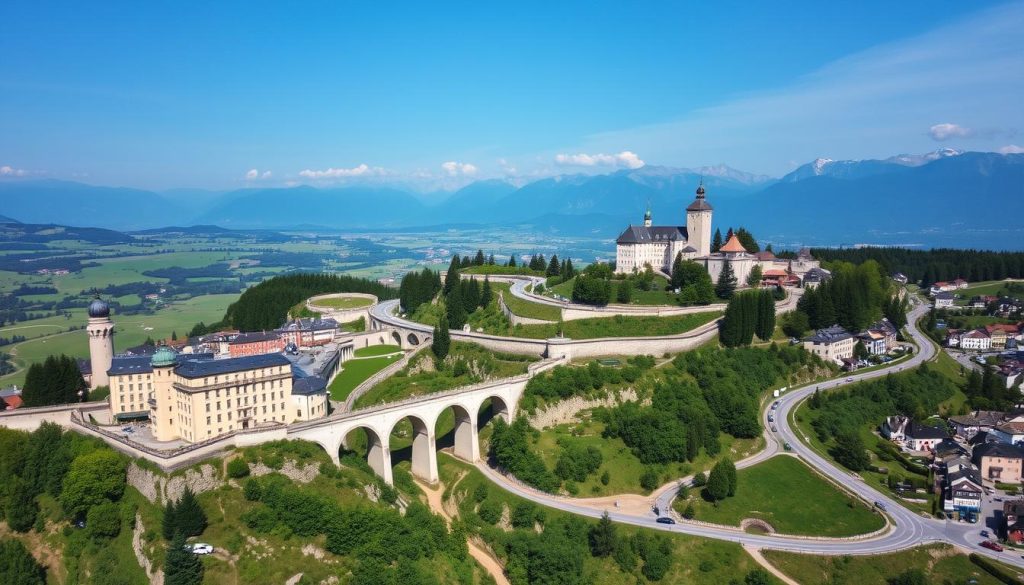
Austria’s history of infrastructure is filled with change and new ideas. It started with ancient Roman roads, which connected the area. These roads were the first step in Austria’s journey with infrastructure.
The Austro-Hungarian Empire saw big growth. Railways were built, making trade and communication easier. This was a key time for Austria’s development.
In the 20th century, Austria kept improving its infrastructure. After World War II, there was a focus on modern transport. This included new roads and better railways. These changes helped connect Austria better and strengthen ties with neighbours.
Now, Austria has modern transport like high-speed trains and city transport systems. Looking back helps Austria plan for the future. It’s important for tackling new challenges and opportunities.
Infrastructure in Austria: Current State and Challenges
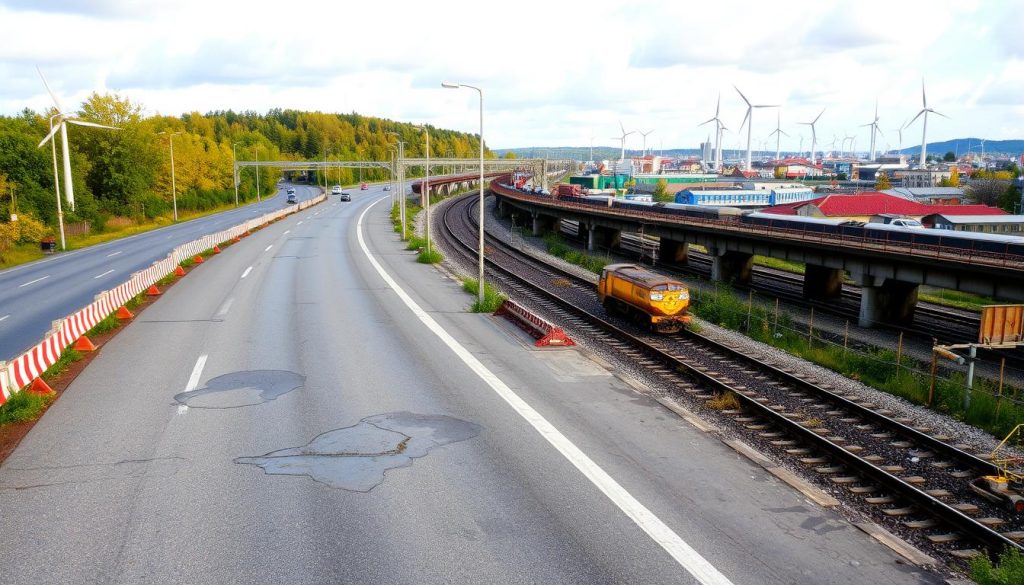
The state of infrastructure in Austria is complex. It has both strengths and weaknesses. Many parts are old and need fixing.
Transport and utility systems are in bad shape. They need urgent repairs to prevent further damage.
Funding is a big problem. The government doesn’t have enough money for big projects. This makes it hard to update old systems.
Many areas, especially rural ones, lack modern infrastructure. This is because of a lack of funds.
Climate change is also a challenge. It makes infrastructure wear out faster. Cities growing fast add to the problem, needing new solutions.
To solve these problems, a mix of public and private efforts is needed. Working together with the community is key. The future of infrastructure depends on these efforts to overcome current issues.
Key Sectors of Infrastructure in Austria
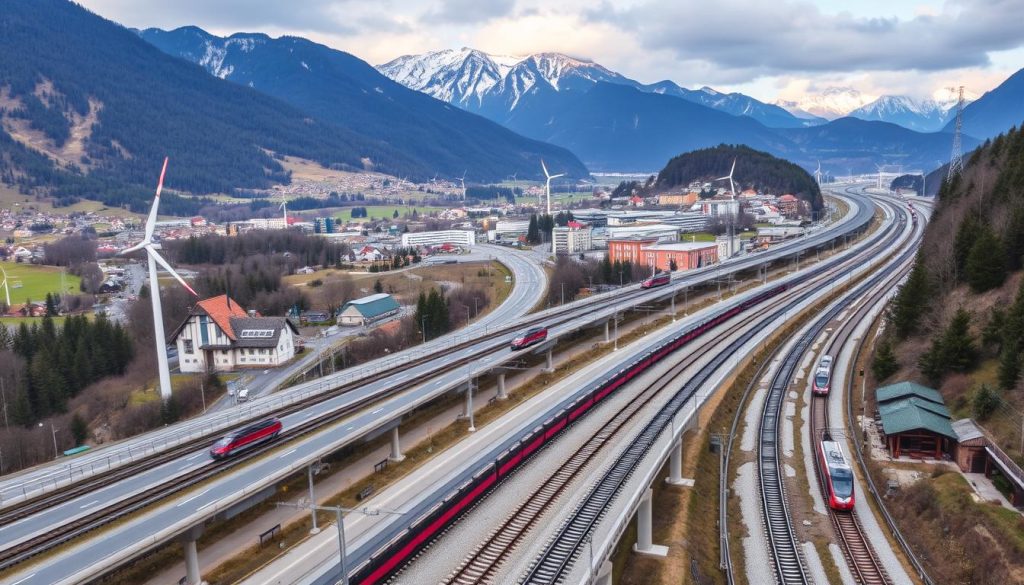
Austria’s infrastructure sectors are crucial for its growth. They include transport, energy, and telecommunication systems. Each sector plays a vital role in the country’s economy.
Transport Infrastructure
The transport network in Austria is key for connecting regions and boosting trade. It features extensive roads and rail systems, including the Austrian Federal Railways (ÖBB). This railway serves millions of passengers every year.
Austria’s motorways are known for their efficiency. They are important for both people and goods moving around the country. Air travel and inland waterways also play a part in cargo transport.
Utilities and Energy Infrastructure
Austria’s utilities and energy sector focus on sustainability. It uses renewable sources like hydropower and wind energy. This reduces the need for fossil fuels.
The country’s water supply systems ensure clean drinking water. Waste management is also advanced, promoting recycling and protecting the environment.
Telecommunication Infrastructure
Austria’s telecommunication systems have improved a lot lately. Modern mobile networks offer fast internet everywhere. This boosts economic activities and improves life quality.
Technology is essential in Austria’s infrastructure. It shows how important it is for the country’s development.
Government Policies Impacting Infrastructure
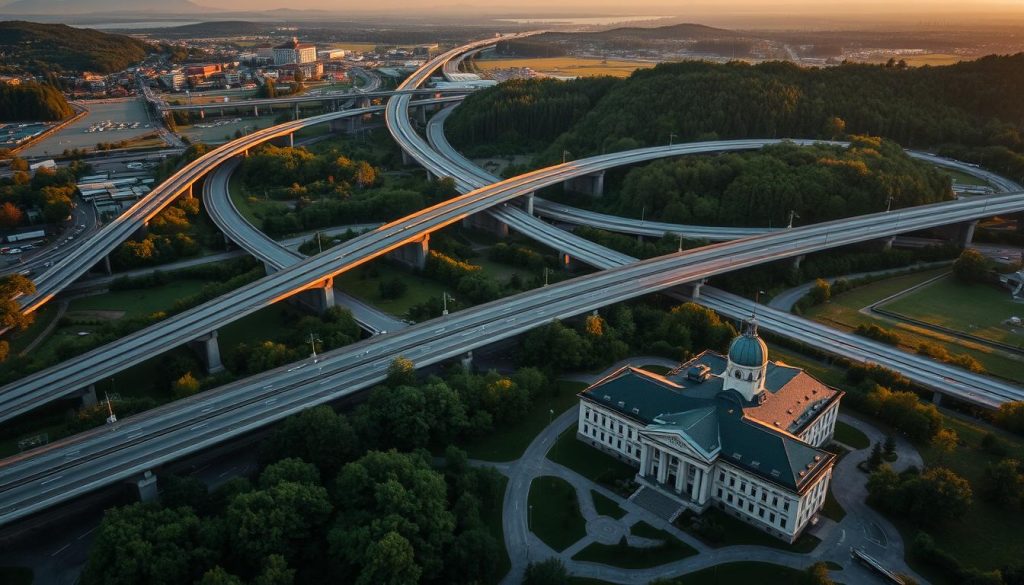
Government policies are key in shaping Austria’s infrastructure. They aim to improve connectivity and boost the economy. These policies include rules and funding that help in starting projects.
Austria’s infrastructure rules follow EU guidelines. They ensure projects are sustainable and safe. These rules cover environmental, land use, and public safety aspects.
Investment policies guide how money is spent on infrastructure. They help the economy grow and improve life for people. Public-private partnerships are common, sharing risks and bringing new ideas to projects.
- Funding mechanisms include grants, loans, and subsidies aimed at both public and private investments.
- Regional disparities are addressed through targeted policies that ensure equal development opportunities across Austria.
- EU funding initiatives complement national efforts, providing additional resources and aligning local projects with broader European objectives.
Public vs. Private Investment in Infrastructure
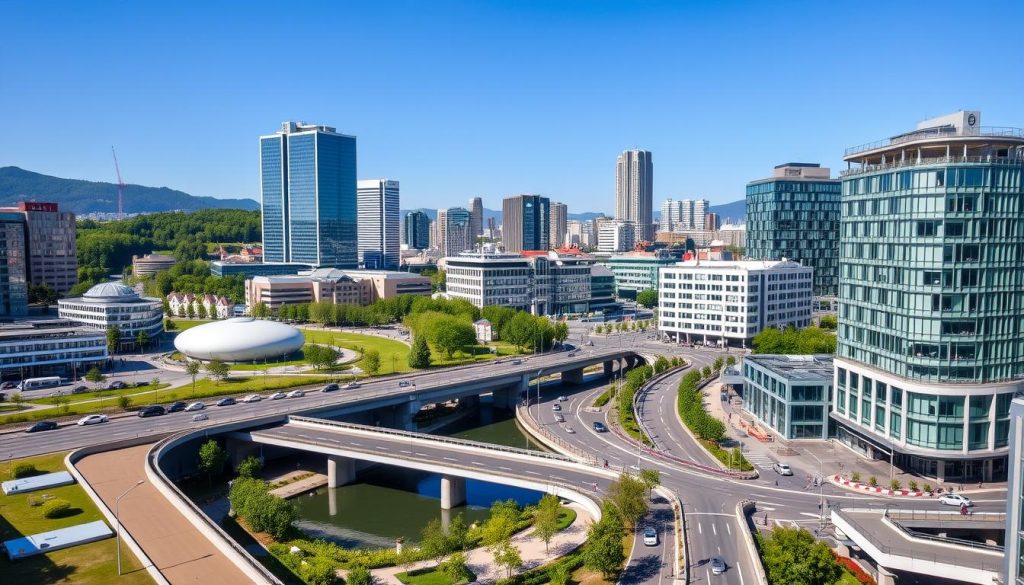
The balance between public and private investment in infrastructure is key for Austria’s growth. Public-private partnerships in Austria help fund infrastructure well. By teaming up, the public and private sectors share resources and skills.
This partnership leads to successful projects. These projects help local communities and the economy grow.
Case Studies of Successful Public Projects
Looking at public projects gives us insights into public-private partnerships. The Vienna International Airport expansion is a great example. It shows how government and private companies can improve travel facilities.
In Graz, urban development projects show the power of good funding. These projects meet community needs. They’ve revitalised areas, boosting local economies and improving life for residents.
Innovation in Infrastructure Technologies
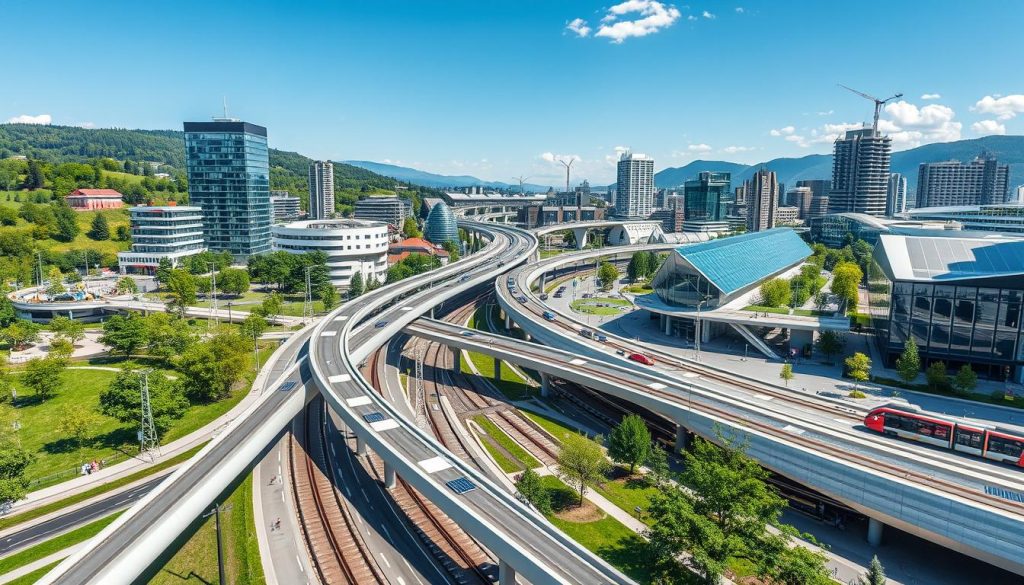
Austria is leading the way in infrastructure innovation. It’s thanks to new technologies that change how we live in cities and towns. The focus is on making things smarter and more sustainable.
Some key innovations are:
- Smart city projects that use data and tech to make life better in cities.
- New building materials that are good for the planet and last longer.
- Using digital tech in planning, for better management and improvement of projects.
Reports show these changes help make infrastructure stronger and boost the economy. In Austria, working together between government and private sectors has been key. This ensures the use of the latest tech.
Sustainability Trends in Austrian Infrastructure
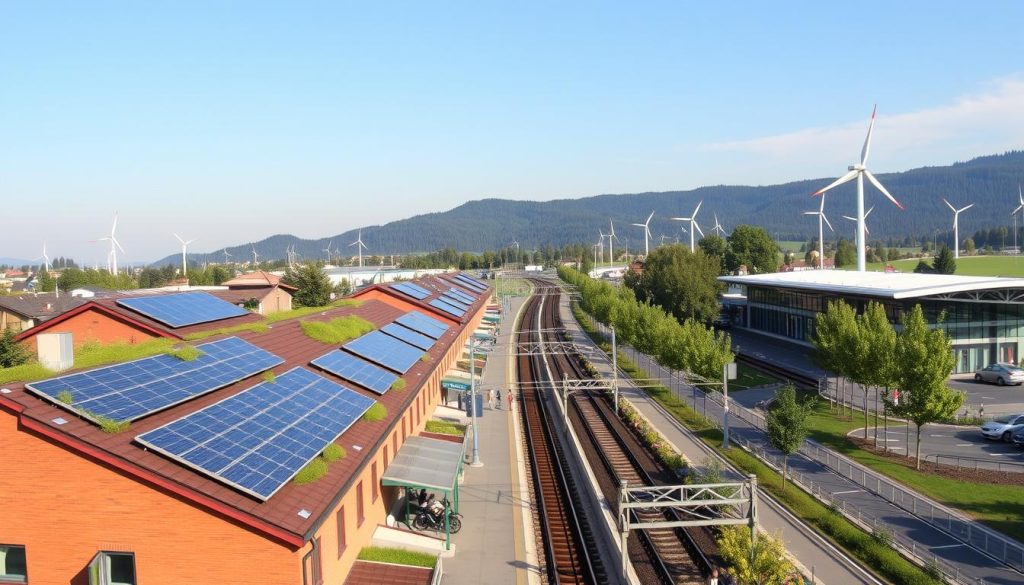
Austria is leading the way in sustainable infrastructure. It focuses on reducing environmental harm. This includes big investments in green energy and eco-friendly building methods.
These efforts show Austria’s commitment to a greener future. It’s all about making the country’s infrastructure more sustainable.
Green Energy Initiatives
Austria is all in on renewable energy. It’s especially strong in hydropower and solar energy. The country is using its natural resources wisely.
Government policies support the use of renewable energy. The goal is to move towards a greener energy system. This will help the economy and protect the environment.
Eco-friendly Construction Practices
Austria is also focusing on eco-friendly construction. Top builders are using sustainable methods and materials. This reduces harm to the environment.
They’re using recycled materials and designing buildings to save energy. These steps help meet Austria’s sustainable goals. They also improve the quality of buildings.
Regional Disparities in Infrastructure Development
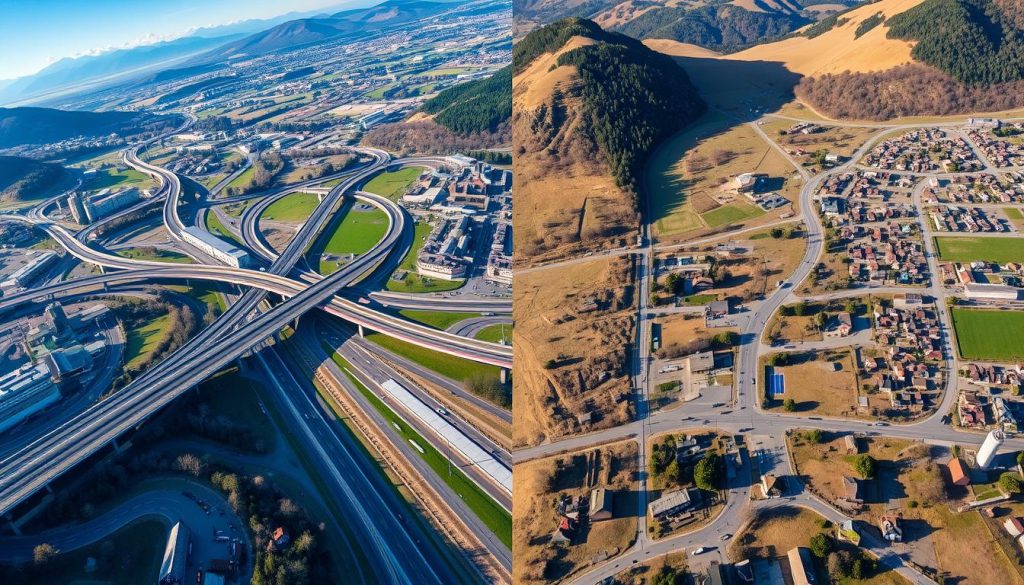
Austria faces big differences in infrastructure across regions. Cities like Vienna have modern transport and communication. But, rural areas often miss out on these basics. This gap affects how easy it is to get around and live in these areas.
Studies show that cities get more investment than rural areas. This makes cities grow more, leaving rural areas behind. It’s important to fix this to make sure everyone has a fair chance to develop.
- Urban areas typically feature:
- Advanced public transport systems
- Robust utility networks
- Comprehensive telecommunication services
- Poor transport connectivity
- Limited access to reliable utilities
- Inadequate broadband coverage
The effects of these differences are huge. They stop people in rural areas from getting jobs and widen the gap between regions. To make things fair, we need to invest in rural areas and help them grow.
Austrian Infrastructure and European Connectivity
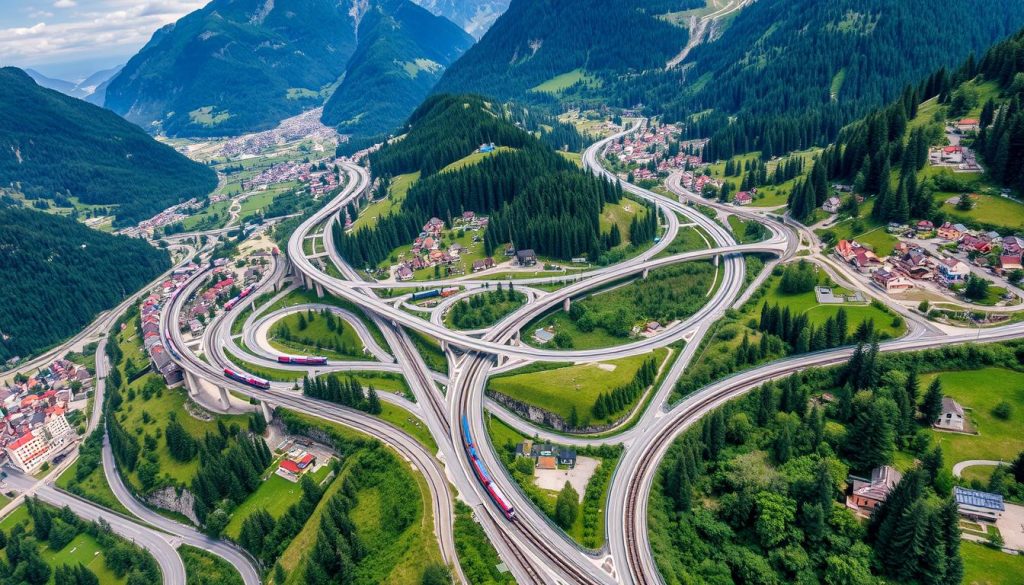
Austria’s infrastructure is key to better transport and energy networks across Europe. It helps move goods and people smoothly across borders. This boosts economic ties between countries.
Strategies like the Trans-European Transport Networks (TEN-T) are crucial. They aim to link Austria with its neighbours more effectively.
Key areas of focus include:
- Cross-border transportation: Creating efficient routes between Austria and its neighbours is vital. Rail and road networks have made travel faster and easier.
- Infrastructure integration: Linking different transport modes ensures Austria stays a key European hub. This boosts trade and tourism.
- Energy networks: Austria’s push for renewable energy fits well with Europe’s goals. Cross-border energy projects support the regional market and green energy.
Austrian infrastructure is essential for better European connectivity. It makes travel and energy use more efficient and sustainable for everyone.
Impact of Infrastructure on Economic Growth
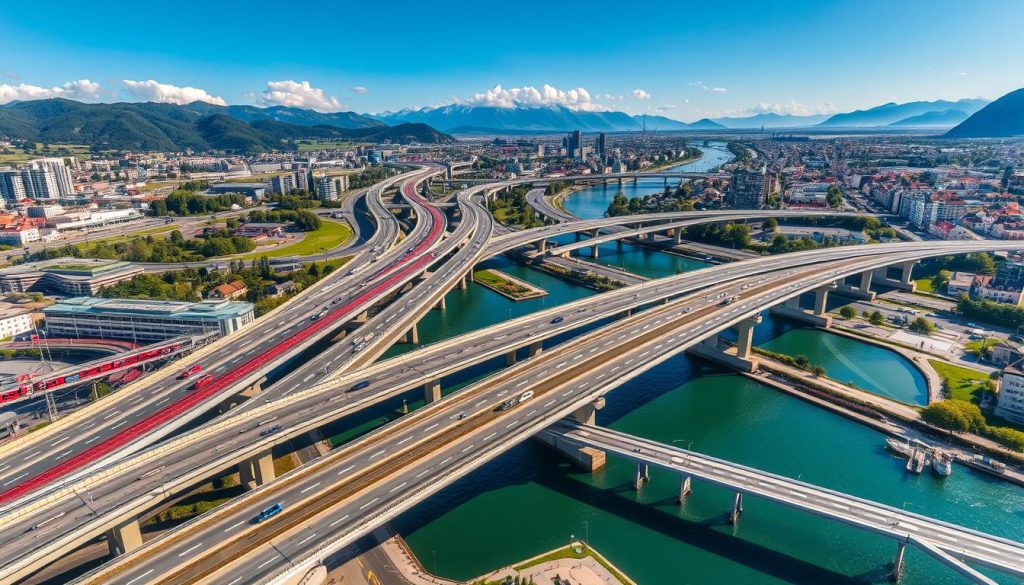
The link between infrastructure and economic growth in Austria is strong and complex. Investing in infrastructure boosts the economy significantly. It creates jobs and helps local areas grow, making the economy vibrant nationwide.
Job Creation through Infrastructure Projects
Infrastructure projects in Austria are key to job creation. Labour statistics show that each investment in roads, bridges, and transport creates many jobs. Construction and engineering sectors see the most benefits, offering a range of jobs from skilled workers to project managers.
Boosting Local Economies
Good infrastructure makes local economies stronger by drawing in businesses and improving trade. Areas with strong infrastructure see economic gains, like higher property values and better living standards. Cities like Vienna and Graz show how modern transport and utilities lead to strong local economies and thriving businesses.
Future Trends in Austrian Infrastructure
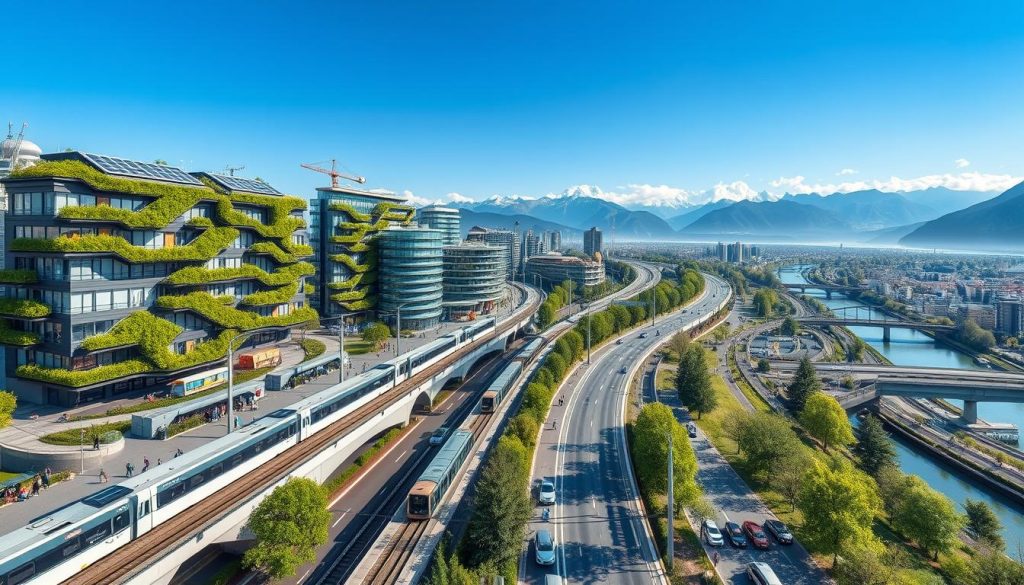
Austria is looking to the future, with new trends in infrastructure. Digitalisation is playing a big role. It’s making systems more efficient and improving how people use them.
Digitalisation and Smart Technologies
Digitalisation is changing how things work. Smart technologies help monitor and analyse data in real-time. This leads to better decisions.
- Enhanced connectivity through IoT devices.
- Data-driven resource management.
- Improved sustainability measures, reducing environmental footprints.
Experts say these changes will make infrastructure stronger and more adaptable. They also make it more sustainable. This means future infrastructure will meet the needs of today and tomorrow.
In short, digitalisation and smart technologies are key for Austria’s infrastructure growth. They’re setting the stage for a more efficient and green future.
Case Studies in Austrian Infrastructure Projects
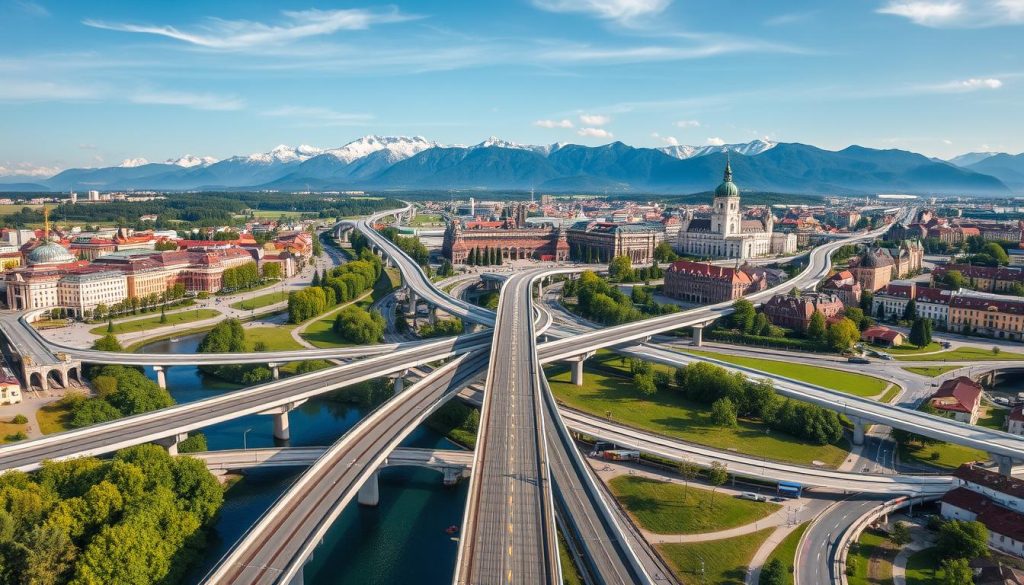
This section looks at key Austrian infrastructure projects. It focuses on Vienna’s transport network and new ways to connect rural areas. These examples show Austria’s strong focus on building solid infrastructure.
Vienna’s Transportation Network
The Vienna transport system is a great example of how to move people well and green. It uses trams, buses, and metro lines to make travel easy for everyone. This mix has brought many benefits, like:
- Less traffic, which is better for the air we breathe.
- It’s easier for people with mobility issues to get around.
- There are now better systems to help plan your trip.
Vienna listens to what people say to keep making its transport better. This is a good example for other cities wanting to improve public transport.
Innovations in Rural Connectivity
Austria is working hard to connect rural areas better. It’s doing this by improving transport and internet in remote places. Some of the projects include:
- Smart transport apps for sharing rides and using local taxis.
- Working with local people to create green transport options.
- Building fast internet in isolated towns.
These efforts show Austria’s dedication to making sure everyone, no matter where they live, has access to modern infrastructure.
Community Engagement in Infrastructure Planning
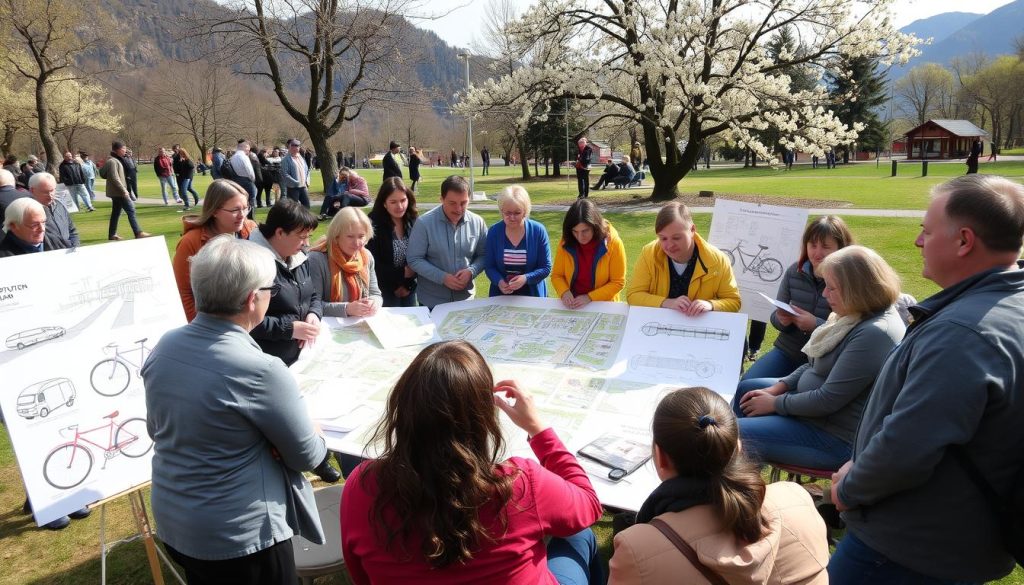
In Austria, getting the community involved is key to good infrastructure planning. It makes people feel like they own the project. It also leads to better decisions because everyone’s voice is heard.
Public consultation is a big part of this. It helps planners get feedback from locals. This can be through meetings, surveys, or workshops. It’s all about talking openly and listening to each other.
Recent projects show how important community input is. When local ideas are used, projects meet community needs better. This not only improves the design but also builds trust and support.
Conclusion: The Way Forward for Austria’s Infrastructure
Austria’s infrastructure is at a crossroads, with both progress and hurdles ahead. The path forward involves embracing new ideas and green practices. By focusing on eco-friendly tech and involving the public, Austria can meet its infrastructure needs.
Adopting strategies that highlight digitalisation and community involvement is key. This approach ensures that infrastructure projects are not just immediate fixes but also contribute to the environment and economy in the long run.
Addressing modern infrastructure needs requires a comprehensive strategy. This includes working together between public and private sectors, using smart technologies, and prioritising sustainability. By taking these steps, Austria can build a strong, efficient, and inclusive infrastructure. This will support its people and help tackle future challenges.

